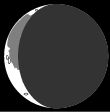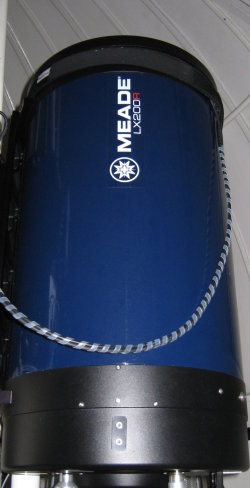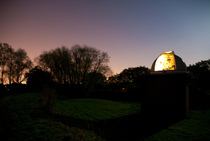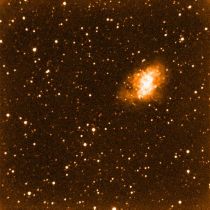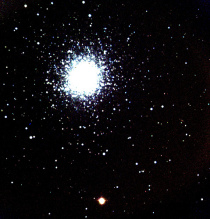Telescope History
|
Prior to the 2013 upgrade project, UBO housed two telescopes: a classical 16 inch diameter Cassegrain telescope that was used for spectroscopic observations, and a 14 inch diameter Schmidt Cassegrain Meade LX200R that was used for direct imaging. For information about our current telescope please see here. Cassegrain
Cassegrain Focus Drive and Encoder: The secondary mirror is mounted on a lead screw which has a linear encoder. There is no temperature compensation, so that focus changes can occur as the telescope structure expands or contracts. A movement of 1 mm of the secondary produces a focus shift at the Cassegrain focus of 15.6 mm. The secondary can move through a range of 30 mm, which moves the Cassegrain focus from -240 mm to +240 mm relative to the Cassegrain mounting plate. The nominal focus is at +70.0 outside the mounting plate surface. This is where the slit of the spectrograph and the aperture stops of the UBV photometer are placed. TV Slit Viewing and Calibration Optics: A mirror at 45 degrees to the optical axis folds the Cassegrain focus on to the Acquisition TV camera. The camera consists of a Collins Electro Optics I3 CCD Video camera which is equipped with a recursive video frame averager. Since the intensifier can be damaged by over illumination it is protected by a bright object sensor. The output from the camera is displayed in the Control Room on a monochrome video monitor. With the acquisition mirror in the DIRECT / CALIBRATION position, the camera can view the Cassegrain field for source acquisition. In this mode light from a calibration lamp can be fed to the spectrograph slit. There are neutral density filters in the calibration beam which can be selected to attenuate the calibration lamps. When the mirror is in the SLIT VIEWING position, the slit can be viewed for spectroscopy. Finder TV Camera This consists of a 150mm focal length lens mounted on a ASTROVID TV Camera. The camera has variable gain and contrast control and the output is shown on a monitor in the control room. The system has a field of view of 2 deg x 1.5 deg and a limiting magnitude of V= +7. Meade LX200RTelescope Specifications:
RefractorMounted on top of the Cassegrain telescope is a 4.5'' (114.3mm) air spaced refractor. This instrument is ideal for observing the moon and planets on open evenings. The focal length is 1646mm, so has a focal ratio of f/14.4 MechanicsThe mounting is an English cross axis equatorial with worm and wheel drives on each axis. The worm wheels have 720 teeth so that 1 revolution of the wheel corresponds to 0.5 degree on the sky. A 15 bit encoder on the worm and an 11 bit encoder on the wheel are combined to obtain Hour angle and Declination angles with a resolution of 0.05 arcsecond. Each axis is driven by a computer controlled DC torque motor. Control SystemThe control system, based on an ACORN A310 computer, was replaced in 2004 by a Linux PC system using code written by Dr Ken Elliott and Intelligent Interfaces. The computer reads a radio clock to obtain the date and UTC, from which local sidereal time is calculated. The telescope Hour angle and Declination are deduced from the encoders. The mean place and equinox of position are entered and these are corrected for precession, nutation and aberration to obtain the apparent place. The telescope coordinates are corrected for atmospheric refraction and for a number of pointing model parameters to give an rms pointing accuracy of about 20 arcseconds. The telescope tracking is updated synchronously at 25Hz and unguided exposures of up to 10 minutes are possible without any detectable tracking error. Further details of the control system are given in a paper published in the Journal of the British Interplanetary Society. |
|
||||||||||||||||||||||||||||||||||||||||||||||||||||

